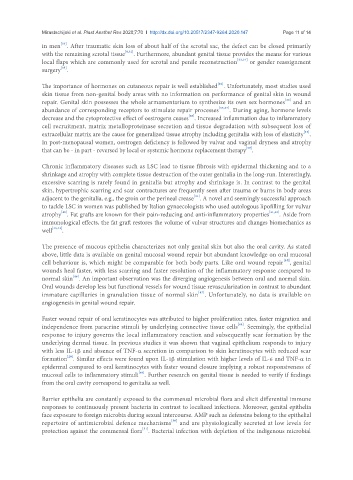Page 835 - Read Online
P. 835
Mirastschijski et al. Plast Aesthet Res 2020;7:70 I http://dx.doi.org/10.20517/2347-9264.2020.147 Page 11 of 14
[31]
in men . After traumatic skin loss of about half of the scrotal sac, the defect can be closed primarily
with the remaining scrotal tissue [8,32] . Furthermore, abundant genital tissue provides the means for various
local flaps which are commonly used for scrotal and penile reconstruction [33,34] or gender reassignment
[35]
surgery .
[10]
The importance of hormones on cutaneous repair is well established . Unfortunately, most studies used
skin tissue from non-genital body areas with no information on performance of genital skin in wound
[36]
repair. Genital skin possesses the whole armamentarium to synthesize its own sex hormones and an
abundance of corresponding receptors to stimulate repair processes [15,37] . During aging, hormone levels
decrease and the cytoprotective effect of oestrogens ceases . Increased inflammation due to inflammatory
[38]
cell recruitment, matrix metalloproteinase secretion and tissue degradation with subsequent loss of
extracellular matrix are the cause for generalized tissue atrophy including genitalia with loss of elasticity .
[15]
In post-menopausal women, oestrogen deficiency is followed by vulvar and vaginal dryness and atrophy
[39]
that can be - in part - reversed by local or systemic hormone replacement therapy .
Chronic inflammatory diseases such as LSC lead to tissue fibrosis with epidermal thickening and to a
shrinkage and atrophy with complete tissue destruction of the outer genitalia in the long-run. Interestingly,
excessive scarring is rarely found in genitalia but atrophy and shrinkage is. In contrast to the genital
skin, hypertrophic scarring and scar contractures are frequently seen after trauma or burns in body areas
adjacent to the genitalia, e.g., the groin or the perineal crease . A novel and seemingly successful approach
[31]
to tackle LSC in women was published by Italian gynaecologists who used autologous lipofilling for vulvar
[40]
atrophy . Fat grafts are known for their pain-reducing and anti-inflammatory properties [41,42] . Aside from
immunological effects, the fat graft restores the volume of vulvar structures and changes biomechanics as
well [43,44] .
The presence of mucous epithelia characterizes not only genital skin but also the oral cavity. As stated
above, little data is available on genital mucosal wound repair but abundant knowledge on oral mucosal
cell behaviour is, which might be comparable for both body parts. Like oral wound repair , genital
[45]
wounds heal faster, with less scarring and faster resolution of the inflammatory response compared to
[46]
normal skin . An important observation was the diverging angiogenesis between oral and normal skin.
Oral wounds develop less but functional vessels for wound tissue revascularization in contrast to abundant
immature capillaries in granulation tissue of normal skin . Unfortunately, no data is available on
[47]
angiogenesis in genital wound repair.
Faster wound repair of oral keratinocytes was attributed to higher proliferation rates, faster migration and
[48]
independence from paracrine stimuli by underlying connective tissue cells . Seemingly, the epithelial
response to injury governs the local inflammatory reaction and subsequently scar formation by the
underlying dermal tissue. In previous studies it was shown that vaginal epithelium responds to injury
with less IL-1β and absence of TNF-α secretion in comparison to skin keratinocytes with reduced scar
formation . Similar effects were found upon IL-1β stimulation with higher levels of IL-6 and TNF-α in
[20]
epidermal compared to oral keratinocytes with faster wound closure implying a robust responsiveness of
mucosal cells to inflammatory stimuli . Further research on genital tissue is needed to verify if findings
[49]
from the oral cavity correspond to genitalia as well.
Barrier epithelia are constantly exposed to the commensal microbial flora and elicit differential immune
responses to continuously present bacteria in contrast to localized infections. Moreover, genital epithelia
face exposure to foreign microbia during sexual intercourse. AMP such as defensins belong to the epithelial
repertoire of antimicrobial defence mechanisms and are physiologically secreted at low levels for
[50]
[51]
protection against the commensal flora . Bacterial infection with depletion of the indigenous microbial

